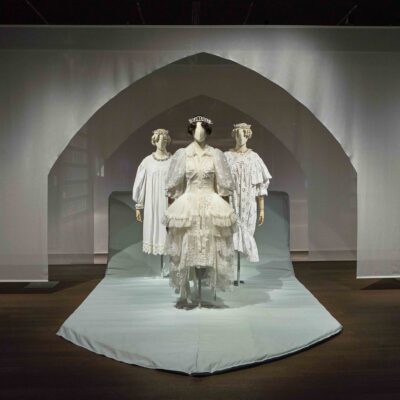
Exhibitions 21.11.2025
12.09.2022
European fashionHaute Coutureirelandmeeting fashion heritage
Introducing our new partner from Ireland
Situated in Limerick in the midwest of Ireland, The Hunt Museum is an eclectic collection of works of art and antiquities, collected over many years by antique dealers John & Gertrude Hunt and gifted to the people of Ireland in 1978. The Hunt Museum also houses arguably one of the largest archives of the designer Sybil Connolly. It was through Hunt’s connection that following the death of designer Sybil Connolly in 1998, the museum was bequeathed her archive, including original couture garments, original design sketches, paper-based press books and homeware designs.
Maybe surprisingly during the 1950s and 1960s Ireland became a very unlikely center for fashion, and this was in no small part the result of the female designer Sybil Connolly and her dedication to using Irish fabrics in her couture designs.
The story of Sybil Connolly’s success was unique, Ireland was far from the world fashion capitals in both distance and influence. Ireland was still a relatively new state, under the strong influence of the church and although modernising, the population was largely rural. Sybil was always metropolitan in her outlook and held a strong belief that Ireland and an Irish woman could compete on the world stage. She was fortunate in a number of serendipitous encounters that helped her career progression. Carmel Snow, editor of Harper’s Bazaar during the 1950s, gave her contacts of buyers in the US. Lady Dunsany of Dunsany Castle, Co. Meath greatly admired Sybil and her designs and offered the Dunsany Castle as the magical backdrop for one of Sybil’s first fashion shows to American buyers. With many of her designs being ball gowns of pleated linen, crochet and dramatic capes of wool and tweed, her designs were made for the couture market but were inspired by traditional Irish style.
Breaking into the couture fashion world in the 1950s Sybil Connolly championed the use of traditional Irish fabrics. She also used and highlighted the importance of Irish craftwork. Donegal embroidery, handwoven Carrickmacross lace, Donegal tweeds, Bánín wool and most notably her own Handkerchief Pleated Linen were incorporated Irish craft into her designs.
During the 1950s & 60s her designs were celebrated across the world, but most especially in the U.S. Women from America’s first lady Jacqueline Kennedy Onassis, to actresses Adele Astaire (musical Funny Face) and Julie Andrews (film Sound of Music) wore Sybil Connolly’s designs. Sybil signature styles were photographed by the top photographers of the time. This included Richard Dormer who photographed Sybil’s white crochet dress and red full length cape for the cover of Life Magazine in 1953. Her designs were featured in Harper’s Bazaar and Vogue throughout the 1950s.
The appreciation and recognition of her designs continued into the 1960s until the prevailing fashion of the 60s began to diverge from Sybil’s signature style, her focus moved from couture fashion to interior design. She did however have the power and imagination to reinvent herself, moving her creativity to interior design products so before homeware diffusion lines became commonplace, Sybil was collaborating with Tiffany, Waterford crystal and wallpaper fabric designers Brunschwig & Fils.
Following a successful crowdfunding campaign, Sybil garments will undergo conservation work, once repaired the Hunt Museum aims to continue to exhibit Sybil garments and archive for the visiting public to enjoy. The publication of sketches by Sybil Connolly with the European Fashion Heritage Association (EFHA) will aid the digital preservation of an important part of Ireland’s fashion heritage. By placing Sybil’s archive into the public domain these sketches can inspire: research, education, and the creative sector.